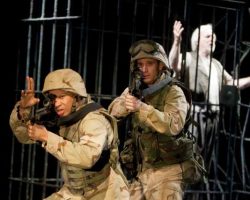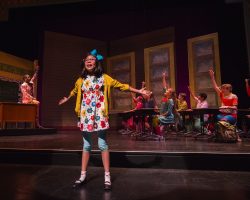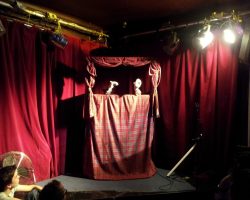
Playwright Zoo
Zoo playwriting?
A resource linking you to some of the coolest new trends as well as classics particular to playwrights and their craft. — And check out the Playwright Zoo Archive for past musings and featured artists.
Polar Bears
The coolest.
Michael R. McGuire is one of the playwrights whose opinion I trust. He’s a theater artist working within his community as a major contributor to the local arts scene in New London, Connecticut. He is a self-taught self-starter who also helps other theater-artists see their work produced. I’ve know Mike for a few decades, and we’ve worked together to co-produce new-play festivals and full-up productions. He founded a playwrights group that meets regularly throughout the year where members bring new work to have it read and discussed (then we all go out for food and beer). He’s the kind of guy you want to have around when you’re trying to get a new piece on its feet. Everybody should have a friend like Mike.
Michael R. McGuire has written plays for the past 16 years. His play SOMETIMES I FEEL LIKE I MISSED THE TRAIN was part of The Lark’s 2004 Playwrights Week and showcased by The Planning Stage at The Golden Street Gallery in 2006. He was awarded a CT Artist Fellowship in 2005 for his play THE NEW GIRL with which he produced a showcase at the Avery Point Playhouse. His plays PERSEPHONE RULES! and THE MISJUDGMENT OF OENONE are published by Brooklyn Publishers.
McGuire founded the playwrights reading group Writers’ Roundtable in 2000.
The interview:
Michael R. McGuire – why the “R”?
There is another playwright in America named Michael McGuire. We were getting one another’s rejection letters returned. The other McGuire has been around longer so I added my middle initial. Plus, it sounds cooler.
You’re a playwright based in Southeastern Connecticut. What are some of the challenges to you as a playwright not being in a big city?
The biggest challenge is the lack of opportunity to network with theater professionals. Literary managers have no face to put with my name. Of course this might also be an advantage…
What are the benefits?
I enjoy being an outsider. Because so many playwrights live in NY, they tend to have a New York sensibility. My New London, CT sensibility is a bit different and informs my writing.
Living in a small arts community like New London County, how essential to you and your work has been the acquisition of production skills?
I have produced, directed and also acted in many of my own productions. It is essential for a playwright to see the work in front of an audience. If opportunities do not present themselves, you must create them.
What makes you want to produce the works of others as well as your own?
I sometimes come across a script that I simply must see on stage. Your play TO DIE FOR WANT OF LOBSTER was one of these. (That it had a great role for me had nothing to do with it)
I do not consider myself an especially skilled director of the works of others and prefer to leave that to others when I can.
Being outside of the mainstream loops and circles that life in New York or another theater hub could offer, how do you get your work out there? Do you have a marketing plan? If so, how does it work?
I wouldn’t call it a plan so much as a dogged tenacity to submit my work to every theater I can find that might be appropriate. In addition to Dramatists Sourcebook, I also search online and scour the resumes of playwrights I admire for theaters they began in.
I keep a database of all my submissions and mail frequently. How does it work? I’m not so sure it does!
While the stereotype of the struggling playwright places him/her in a room, alone, flushing out genius across pages, waiting for discovery – how does it really work from your experience? Are you alone or do you depend on others?
I write in coffee shops. I need a bit of hubbub to write. Silence is deadly to me. I read a great deal and consider all writing as part of a larger conversation. Nothing is created in a vacuum. Our playwrights group Writers’ Roundtable has been a valuable resource for feedback and inspiration.
How did you find other artists in your small-town community to work on your plays?
Mine is a theater-heavy small-town due, in part, to our proximity to The O’Neill. New London has an artistically thriving if financially struggling community. I am also fortunate to have an actress girlfriend, Heidi Harger, who has inspired imagery for more than one of my plays.
What resources are do you use to expand your knowledge of writing? What’s available when you’re off the beaten path?
Given Amazon.com everything that is available elsewhere is available here. The works of Gary Garrison, Jeffery Sweet and Stuart Spenser have been valuable, especially early on. Reading the works of current playwrights has also been important. I have to travel a bit to see professional theater, but every playwright should watch live theater.
You recently participated in a 24-hour play experiment, which was the first of it’s kind in the New London area – what was that like? What was unexpected?
We were given an assignment in the evening and had to have a 10 page play written by morning. The plays were handed off to randomly selected actors and director who rehearsed and had the play before an audience that night. It was fun for me because I didn’t have to direct it myself, a rare treat.
Unexpectedly my director, unknown to me before the project, is interested in an on-going collaboration on future plays.
You’ve also participated in the now defunct Local Playwrights Festival at the O’Neill Theater Center, which was produced and performed by all Connecticut and Rhode Island based volunteers to present workshops of plays by local authors – how relevant was that earlier experience for you?
Having an early play (WHAT’S GONNA SET YOU FREE?) selected for that festival was the encouragement I needed at that time to let me know I might be in the right business. It also introduced me to other playwrights and the local theater community at large. It is impossible to overstate the importance of that event. You may blame them for all my subsequent scribbling.
Any plans for the short play that came out of that?
I’m not much of a short play writer in general, but I may send it out here and there.
What are some recommend reads for playwrights?
I mentioned some writers above, and of course read any play you can get your hands on, but also read magazines, novels, comic books, essays and everything else. Ideas are everywhere. I could live ten lifetimes and not run out of ideas.
What do you recommend a playwright order from the bar when being taken out after a showing of one of his/her plays?
If the show went well, have a Guiness or two. Remain sober enough to absorb the praise. If the show went poorly, start pounding whiskey. I accept no responsibility for anyone who follows this advice.
Anything else?
Learn the rules and then break them with style.
The Monkey House
Musings on the state of theater-arts
A Playwright & Web Forums: How to Use Them for the POWER OF GOOD
(your good & others)
from the mind of Kato McNickle
There are a lot of playwright specific forums, groups on Facebook or MySpace, and other web-based cyber-groups floating around. One thing I’ve noticed from participating in these forums and groups is that about 1 outta 50 playwrights actually knows how to interface, interact, and maximize the potential of these virtual porticoes. How savvy are you when it comes to participation thru posting? Are you that one or the other 50?
If that forum your a member of was a theater — what would you do with it? Would you really only tap on the mike once our twice, see if it was on, and only leave a brief calling card — or would you do more? Can you do something more memorable, more lasting, more significant with your stage-time?
I think sites such as these are like stage-time. How can you do more than leave a calling card? How can you use this forum to make a statement — to leave an impression? From impressions come connections. The connections are what we seeks as artists.
Visit the Playwright Zoo Archive.
Creative Creatures
Workshops for the writer @ Kripalu Center for Yoga & Health
Writing as a spiritual practice, a creative path, or as a way to re-vision your life story helps you access the thoughts behind your thoughts and experience a new intimacy with yourself. Writing helps us make friends with our inner critic, freeing us to create and express without inhibition.
Kripalu provides a welcoming environment in which to turn inward toward the words that are calling you-and offers you a variety of skilled teachers to guide you on the next step of your writing journey.
FastLinks to theaters
These theaters accept unsolicited plays
Actors Theatre of Louisville
Louisville, KY. National 10-minute play contest.
Act II Playhouse
Ambler, PA. Full length plays, musicals, and solo pieces.
African Continuum Theatre
Washington, DC. Multicultural work relevant to African-American community.
Alabama Shakespeare Festival
Montgomery, AL. Plays from Southern writers with Southern or African-American themes.
Amas Musical Theatre, Inc.
NYC. Multicultural casts and themes.
ART Station
Stone Mountain, GA. Full-length plays, musicals, solo pieces that describe Southern experience.
Asian American Theatre Company
San Francisco, CA. Innovative rendrings about the Asian American experience.
Bristol River Theatre
Bristol, PA Cutting-edge works, plays that experiment with form.
Celebration Theatre
West Hollywood, CA. Plays not previously produced that provide a prgressive gay and lesbian voice in contemporary theatre.
Centre Stage-South Carolina
Greenville, SC. Full-length, unproduced plays.
City Theatre
Miami, FL. One acts only that represent a diverse mix of subjects and themes.
Columbus Children’s Theatre
Columbus, OH. Social issue one-acts acceptable for audiences in grades K-5.
Dad’s Garage
Atlanta, GA. Full-length nontraditional plays, comedies.
Detroit Repertory Theatre
Detroit, MI. Full-length issue oriented plays.
East West Players
Los Angeles, CA. Plays by or about the Asian American experience.
El Centro Su Teatro
Bilingual and/or Spanish language plays, plays dealing with the Chicano/Latino cultural asthetic or political experience.
Express Children’s Theatre
Houston, TX. Plays for young audiences.
5th Avenue Theatre
Seattle, WA. Adventure Musical Theatre: ongoing program that commissions original musicals performed for K-6 students.
Foothill Theatre
Nevada City, CA. Seeks full-length plays. New Voices of the Wild West: annual spring series of plays about the rural American West.
Growing Stage Theatre
Netcong, NJ. Accepts plays with a production history suitable for family audiences.
Hangar Theatre
Ithaca, NY. Accepts one-acts for for young audiences only.
Huntington Theatre
Boston, MA. Accepts plays from Boston area playwrights only; agent submission all others.
Jewish Theatre of the South
Atlanta, GA. Works on Jewish themes.
Jobsite Theater
Tampa, FL. Topical, politically and socially relevant theatre; plays appealing to 20- and 30- somethnings.
Kitchen Dog Theater Company
Dallas, TX. Plays from Texas and Southwest playwrights.
Kuma Kahua Theatre
Honolulu, HI. Plays set in Hawaii or dealing with Hawaiian experience.
Merry-Go-Round Playhouse
Auburn, NY. Plays for young audiences.
Mill Mountain Theatre
Roanoke, VA. Accepts unsolicited one-acts for CenterPieces reding series only.
Miracle Theatre Group
Portland, OR. Hispanic playwrights, plays that deal with the Hispanic experience.
Mu Performing Arts
Minneapolis, MN. Asian-American expeience, plays combining traditional Asian performance with Western theatre styles, short plays suitable for school tours.
New Georges
NYC. plays by women only, works with vigorous use of language and heightened perspectives on reality.
New Jersey Repertory Company
Long Branch, NJ. Work not produced professionally, social or humanistic themes.
A Noise Within
Glendale, CA. Translations or adaptations of classical material only.
Oldcastle Theatre Company
Bennington, VT. Accepts musicals and plays.
OpenStage Theatre & Company
Fort Collins, CO. Accepts full-length plays.
Oregon Children’s Theatre
Portland, OR. Plays and musicals for young and family audiences.
Playhouse on the Square
Memphis, TN. Full-length plays and musicals.
Playwrights Horizons
NYC. American writers only, works with strong sense of language that take theatrical risks.
Porchlight Music Theatre Chicago
Chicago, IL. Full-length and one-act musicals.
Sanctuary: Playwrights Theatre
Brooklyn, NY. Accepts playwrights with at least one professional production only; prefers plays with unusul structure, radical core ideas, epic form, work that’s off the map or otherwise seen as impractical.
Seattle Children’s Theatre
Seattle, WA. Accepts unsolicted plays for Drama Summer School season only: one-act plays suitable for young actors.
Seem-To-Be-Players
Lawrence, KS. Plays for young audiences.
Soho Repertory Theatre
NYC. Accepts unsolicited scripts for Writer/Director Lab only, deadline: May.
TADA! Youth Theater
NYC. Plays for young audiences.
Thalia Spanish Theatre
Sunnyside, NY. Plays with Hispanic themes.
Theater by he Blind
NYC. Works by and about being blind.
Theater for the New City
NYC. Experimental American works; plays with poetry, music, and dance; social issues.
Trustus Theatre
Columbia, SC. One-acts for late night series – 45-75 minutes in length. No topic or experimental structure is taboo.
Two Chairs Theater Company
Grand Junction, CO. Full-length, one-acts, 10-minute plays. Annual short play fest, deadline Jan. 31.
Unicorn Theatre
Kansas City. MO. Full-length contemporay social issues.
Victory Gardens Theater
Chicago, IL. Accepts plays from Chicago residents only. All others submit 10-page sample and letter of inquiry.
VS Theatre Company
Los Angeles, CA. Accepts unique and edgy full-length unproduced plays with submission form.
West Coast Ensemble
Los Angeles, CA. Plays not previously produced in Southern California.
Wings Theatre Company, Inc.
NYC. Gay themed musicals and plays only.
The York Theatre Company
NYC. Small cast musicals.


